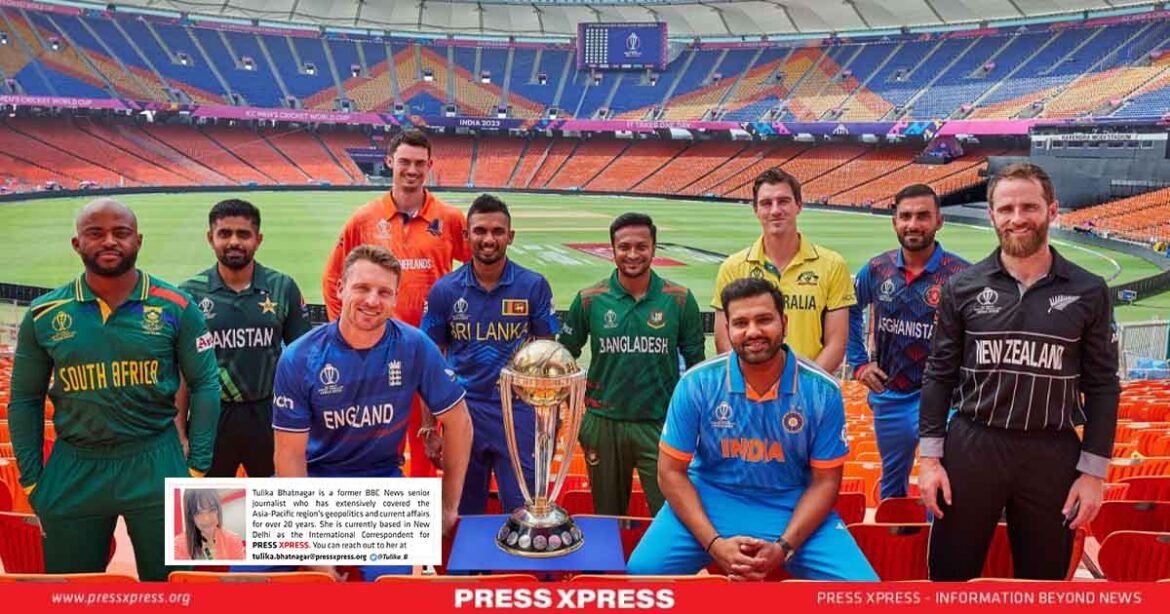Bangladesh has had its first face off against Afghanistan in the ICC Men’s Cricket World Cup, in a week that has seen the sport’s marquee event begin without the spectacular mass audiences India is historically known for.
Bangladesh played Afghanistan in Dharamshala – the foothills of the Himalayas – in the highest cricket venue in the world.
Earlier, Pakistan won against Netherlands in the southern city of Hyderabad, while New Zealand garnered a victory against defending champions England in the western Ahmedabad city, in an opener that got more coverage about its lack of audiences than the game itself.
With 42 more matches to go, opinions are mixed at the start of the tournament about the relevance of the championship in its current format.

Critics point out that T20 has been the disruptor, grabbing eyeballs and media headlines more frequently than the ODI (one-day international).
Rahul Dravid, former cricketer and head coach of the Indian team agrees. “With more and more of T20 cricket being added to the calendar, it will make it difficult to potentially have the same number of one-day games,” he says. “I don’t think we will ever go back to those days (of more ODI games) but I sincerely hope that we will still keep valuing and playing this format.”
T20 is the 20-over format, which is much shorter than the ODI’s 50-over format.

The T20 World Cup also happens every two years, compared to the four-year duration for the ODI World Cup. In a world going towards shorter and shorter attention spans, one-day cricket ironically seems to be in the same place that Test cricket was years ago, when one-day was the disruptor.
More importantly, the commercial success of the T20 leagues has been unrivalled. By rough estimates, the Indian Premier League of T20 in its latest season in 2023 attracted advertisements amounting to 100 billion rupees ($1.2 billion), 65% of which was earned by the governing body, the BCCI (Board of Control for Cricket in India).
In comparison, the ICC Men’s Cricket World Cup is expected to generate around 20 billion rupees ($240 million) in combined ad revenue, according to brokerage firm Elara Capital.
All is not lost
Regarding the World Cup opener, let’s avoid giving the impression of “empty stadiums”, argues Vishal Yadav, founder and CEO of Female Cricket platform, who also runs a woman’s cricket academy in Mumbai.
“The Narendra Modi stadium wasn’t packed,” Yadav told PressXpress in an exclusive interview. “But there are several reasons for that, including the fact that it is mid-week and a working day for families and school children,” he argued.
More people flocked to the stadium in the evening when the day’s work was done and weather was more pleasant, he added.
Read full interview here: ‘Men’s one-day cricket has been losing its appeal’
However, Men’s one-day cricket does seem to be losing its appeal and the tournament could have benefitted from better marketing, Yadav points out.
Still, as the event is being held just ahead of the festive season, India is likely to gain economically.
According to an estimated by the Bank of Baroda, reported by the Times of India, the country’s GDP is likely to benefit by $2.6 billion from World Cup revenues.
Some matches, such as an India-Pakistan cricket clash in mid-October have already seen a 200% jump in hotel reservations in the host city, according to MakeMyTrip travel portal.
Still, as the event is being held just ahead of the festive season, India is likely to gain economically.
According to an estimated by the Bank of Baroda, reported by the Times of India, the country’s GDP is likely to benefit by $2.6 billion from World Cup revenues.
Some matches, such as an India-Pakistan cricket clash in mid-October have already seen a 200% jump in hotel reservations in the host city, according to MakeMyTrip travel portal.

Favourites to win
Five-time champions Australia are emerging as a strong contender for repeating their success at the tournament.
Defending champions England were being considered a favourite too, before the tournament began, but have faced a reality-check in the opener match, losing against New Zealand.
India is another hot favourite among cricket fans, experts, as well as chatter from the betting market, local media report. India last won the World Cup in 2011 on home soil.
According to leading sports monthly Sportstar, India’s overall win percentage since the inaugural World Cup in 1975, is 63.09% with 53 wins in 84 matches. “However, India has the poorest record playing against Australia in World Cups, winning only 4 of 12 matches,” the monthly reports.
If last three editions of World Cup Cricket are anything to go by, the home teams have been at an advantage, says the ICC (international cricket council), the global governing body of cricket.
“Since 2011, a home team has triumphed every time with India setting the trend, which Australia, and most recently, England followed,” the ICC observes in an exclusive media note shared with accredited journalists.
“Now the (2023) tournament returns to where this trend started, and all eyes will truly be on India.”

The 13th edition of the ICC Men’s Cricket World Cup has announced a $4 million prize money for the winning team, along with the coveted trophy that they will lift at the Narendra Modi Stadium in Ahmedabad on 19 November.


